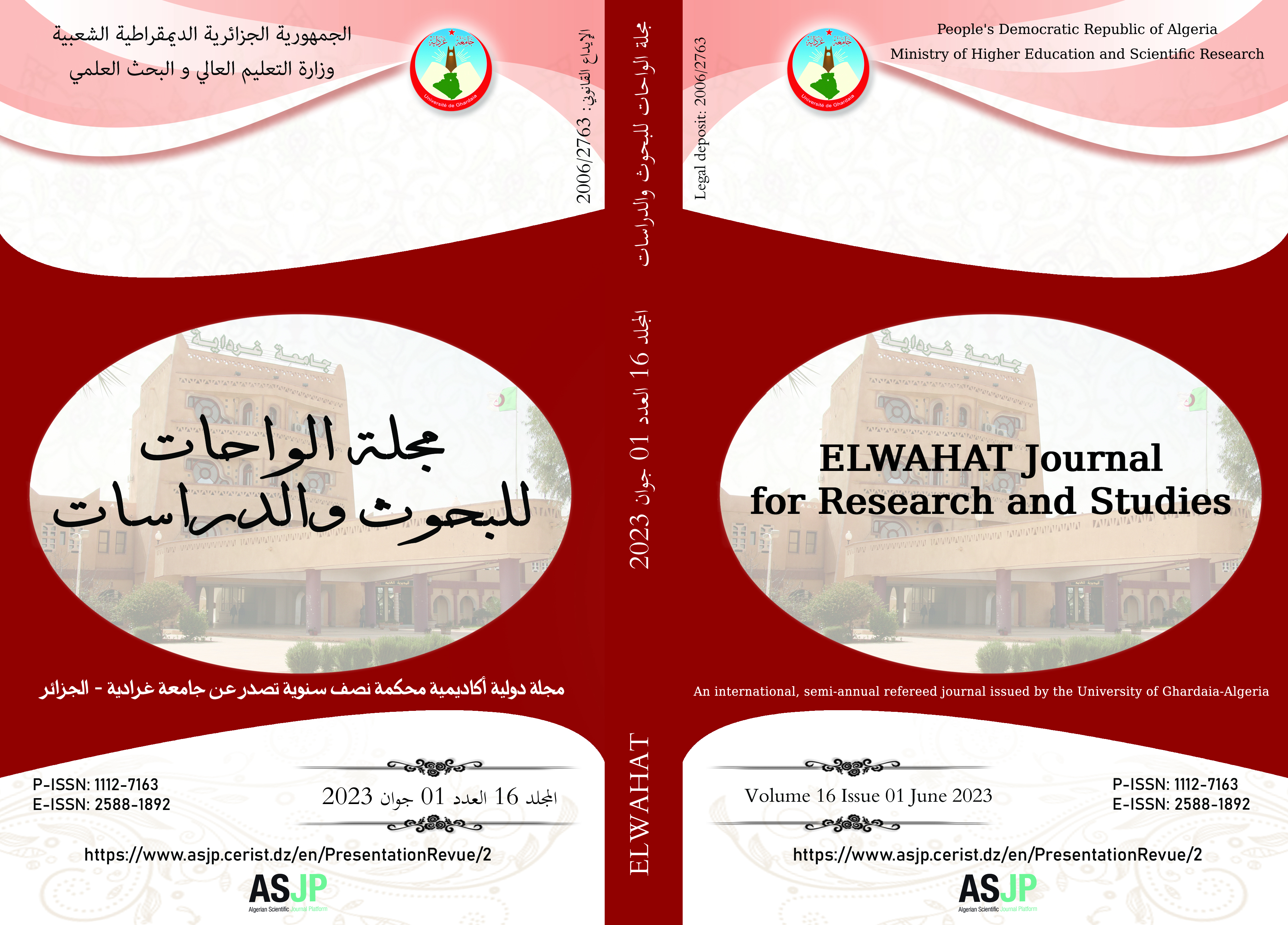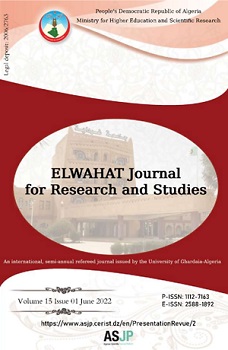Using Technology-Mediated Task-Based Approach in Foreign Language Classes
DOI:
https://doi.org/10.54246/887cyn52Abstract
Abstract:
Research in the field of foreign language teaching found a plethora of language teaching approaches all with the aim of giving both teachers and students a good teaching/learning experience. The task-based approach (TBA) of language teaching was one of those attempts and its synergy with technology became an interest to scholars in the field of language teaching. Therefore, this paper offers insights into the characteristics of technology-mediated task-based language instruction, its advantages, and barriers to its successful implementation.
Keywords: task-based approach, technology, technology-mediated language learning, technology-assisted language learning, technology-mediated task-based instructions.
الملخص:
توصل البحث في مجال تدريس اللغة الأجنبية إلى عدد كبير من مناهج تدريس اللغة بهدف منح المعلمين والطلاب تجربة تعليمية / تعليمية جيدة. كان النهج القائم على المهام (TBA) لتدريس اللغة أحد تلك المحاولات وأصبح تعاونه مع التكنولوجيا محل اهتمام الباحثين في هذا المجال إذا كان تدريس اللغة. لذلك ، تقدم هذه الورقة نظرة ثاقبة لخصائص تعليم اللغة القائم على المهام بوساطة التكنولوجيا ومزاياها والعوائق التي تحول دون تنفيذها الناجح.
كلمات دالة: النهج القائم على المهام ، التكنولوجيا ،تعلم اللغات بمساعدة التكنولوجيا، التعليم القائم على المهام بوساطة التكنولوجيا
References
The emerging field of technology-mediated task-based approach to teaching (TMTBA) poses many challenges to educators in the field of language teaching. The difficulty of blending these two fields together is because they require certain digital skills on behalf of teachers and learners in addition to the need of providing the necessary technology tools for Technology-mediated task-based classrooms. Still, looking back to the body of research we shared earlier in this paper, the inclusion of technology in task-based instruction should be considered to improve the quality of foreign language teaching and learning.
References
Abraham, A. P. (2015). Teaching and Learning to Write: Using a Task-Based Approach in an EFL class (V. S. Thakur & A. Roscoe, Eds.). In A. Rahma (Ed.), Methodologies for Effective Writing Instruction in EFL and ESL Classrooms (pp. 115-130). Hershey PA: Information Science Reference
Ahmed, R. Z., & Bidin, S. J. B. (2016). The Effect of Task Based Language Teaching on Writing Skills of EFL Learners in Malaysia. Open Journal of Modern Linguistics, 6, 207-218. https://file.scirp.org/pdf/OJML_2016060815420360.pdf
Chapelle, C. A. (2001). Computer Applications in Second Language Acquisition. Cambridge: Cambridge University Press
De Ridder, I., Vangehuchten, L., & Gómez, M. S. (2007). Enhancing automaticity through task-based language learning. Applied Linguistics, 28(2), 309–315.
DeKeyser, R.M. (2007). Introducion : Situating the concept of practice. In R.M. DeKeyser (Ed.),: Perspectives from applied linguistics and cognitive psychology (pp. 1-18). Cambridge: Cambridge University Press.
Doughty, C. J., & Long, M. H. (2003). Optimal psycholinguistic environments for distance foreign language learning. Language Learning & Technology, 7, 50-80. Retrieved from https://scholarspace.manoa.hawaii.edu/bitstream/10125/25214/1/07_03_doughty.pdf
Ellis, R. (2003). Task-based Language Learning and Teaching. Oxford: Oxford University Press.
Elola, I., & Oskoz, A. (2010). Collaborative writing: fostering foreign language and writing conventions development. Language Learning & Technology, 14(3), 51–71. Retrieved from http://llt.msu.edu/issues/october2010/elolaoskoz.pdf
Ganta, T. G. (2015). The strengths and weaknesses of task-based learning (TBL). Scholarly Research Journal for Interdisciplinary Studies, 3(16), 2760-2771
Hampel, R. (2006). Rethinking task design for the digital age: A framework for language teaching and learning in a synchronous online environment. ReCALL, 18, 105–121
Harmer, J. (2009) Doing Task-Based Teaching ⋅ Tasks in Second Language Learning. ELT Journal, 63/2, 173–176
Hiradhar, P. (2015). Task-based pedagogy in technology mediated writing. In Proceedings of 17th International CALL Conference: Task design and CALL, pp. 21-26. Tarragona, Spain: Universitat Rovira i Virgili
Khoshima, H. and Saed, A. (2016). Task-based instruction and vocabulary learning a comparative study of jigsaw and information gap tasks on vocabulary learning. International Journal of Applied Linguistics and English Literature, Volume 5, Number 5, 2016, pp. 228-236(9)
Kress,G.R.(2003).Literacy in the New Media Age. London: Routledge Falmer.
Lai, C., & Li, G. (2011). Technology and task-based language teaching: A critical review. CALICO Journal, 28, 1–24.
Larsen-Freeman, D. (2000). Techniques and Principles in Language Teaching (2nd ed.). New York: Oxford University Press
Le, T.N., & Nguyen, H.B. (2012). Task-based language learning and student motivation in vocabulary acquisition. Language Education in Asia, 3(1), 106-120.
Lewis, M (1993) The Lexical Approach. LTP Teacher Training.
M. Gonzalez- Lioret, (2015). A Practical Guide to Integrating Technology into Task-based Language Teaching. Washington D.C. Georgetown University Press
M.,González-Lloret, & L.,Ortega. (2014). Towards technology-mediated TBLT: An introduction. In González-Lloret, M. & Ortega, L.(Eds.), Technology-mediated TBLT: Researching technology and tasks (pp. 1–22). Amsterdam, the Netherlands: John Benjamins.
Marta, G.-L. (2020). Using technology-mediated tasks in second language instruction to connect speakers internationally. In Using Tasks in Second Language Teaching: Practice in Diverse Contexts. Blue Ridge Summit Multilingual Matters.
NamazianDost, I., Bohlouzadeh, G. and Pazhakh, A. (2017). The effect of task-based language teaching on motivation and grammatical achievement of EFL junior high school students. Australian International Academic Centre, Australia, 8(2), 243-59. Available at : https://files.eric.ed.gov/fulltext/EJ1144062.pdf
Newton, J. (2001). Options for vocabulary learning through communicative tasks. English Language Teaching Journal, 55(1), 30-37.
Nunan, D.. 2004. Task-Based Language Teaching. Cambridge: Cambridge University Press.
Prabhu, N.S. (1987). Second Language Pedagogy. Oxford: Oxford University Press.
Reinders,H.,&White,C.(2010).The theory and practiceof technology in materials development and task design.In N.Harwood (Ed.),Materials in ELT: Theory and practice (pp.58- 80).Cambridge:Cambridge University Press.
Richards, J. C., & Renandya, W. A. (2002). Methodology in Language Teaching. Cambridge: Cambridge University Press. http://dx.doi.org/10.1017/CBO9780511667190
Richards, J.C., J. Platt, J. and H. Weber. 1985. Longman Dictionary of Applied Linguistics. London: Longman
Sarani, A., & Sahebi, L. F. (2012). The impact of task-based approach on vocabulary learning in ESP courses. English Language Teaching, 5(10), 118-128
Thomas M., Reinders H. (Eds.), (2010). Task-Based Language Learning and Teaching with Technology. New York: Continuum Publisher
Weller, M. (2007) Virtual Learning Environment : Using, choosing and deeveloping your VLE. London and New York Routledge.
Willis, D. & Willis, J. (2007). Doing Task-based Teaching. Oxford: Oxford University Press.
Willis, J (1994). Task- based language learning as an alternative to PPP. (The Teacher Trainer 8/1)
Woodward, T (1993). Changing the basis of pre-service TEFL training in the UK. (IATEFL TT SIG 13)
Ziegler, N. 2016. Taking technology to task: technology-mediated TBLT, performance, and production. Annual Review of Applied Linguistics 36: 136–63.






